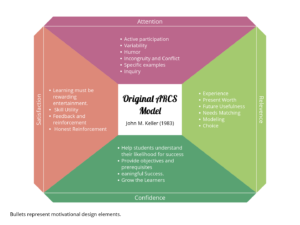Motivation
Keller’s ARCS Model: Integrating Ideas About Motivation
The shared attributes of the different motivational concepts constitute the acronym ARCS, attention, relevance, confidence, and satisfaction, representing Keller’s four categories of learner motivation (Keller, 2010). The ARCS model describes strategies for stimulating and sustaining motivation in each of the four categories as well as a systematic process of motivational design.
Figure 6.12.1. The ARCs Model
The first category, attention, is related to stimulating and maintaining learners’ interests. The learner’s attention is required before any learning can take place. This attention should also be sustained in order to keep learners focused and engaged. Keller (2010) describes three categories of attention-getting strategies: perceptual arousal, inquiry arousal, and variability. Perceptual arousal refers to capturing interest by arousing learners’ senses and emotions. This construct is conceptually similar to triggered situational interest in Hidi and Renninger’s (2006) development of interest. Likewise, perceptual arousal is usually transitory. One of the most common ways to provoke perceptual arousal is making an unexpected change in the environment. Example tactics include a change in light, a sudden pause, and presenting a video after text-based information in an online learning environment. Inquiry arousal, similar to the construct of maintained situational interest, refers to a cognitive level of curiosity. Students are cognitively attracted to learning materials, for instance, when they contain paradoxical facts. Variability concerns variation in instructional methods. No matter how effective motivational tactics are, they lose their potency when used unvaryingly.
The second category, relevance, refers to making the learning experience personally relevant or meaningful. According to the goal theory, students engage in learning activities that help to attain their goals (Locke & Latham, 1984). Also, as described in expectancy-value theory and self-determination theory, the perceived value of the task is a critical antecedent of motivation (Deci & Ryan, 2000; Wigfield & Eccles, 1992). One way to establish the perceived relevance of the learning materials is to use authentic or real-world examples and assignments. Simply relating the instruction to what is familiar to learners (e.g., prior knowledge) can also help learners to perceive its relevance.
The confidence category is pertinent to self-efficacy and expectancies for the success of the expectancy-value theory. According to self-determination theory, the feeling of competence is one of the basic human needs (Ryan & Deci, 2000). If the learners’ need for competence is not satisfied during learning, they would develop low expectancies for success and demonstrate low self-efficacy, which results in poor motivation to learn (Bandura, 1997; Wigfield & Eccles, 2000). Strategies to enhance self-efficacy, such as the experience of success, can be applied in order to build confidence in instruction. Another way to enhance confidence is to foster learners’ belief that they have control over their performance. Autonomy support such as providing choices and making internal, controllable attributions are a few examples.
The last category, satisfaction, concerns learners’ continued motivation to learn. If they experience satisfying outcomes, students are likely to develop a persistent desire to learn (Skinner, 1963). Satisfying or positive consequences of instruction can result from both extrinsic and intrinsic matters (Ryan & Deci, 2000). High grades, certificates, and other tangible rewards are the most common extrinsic outcomes. However, these extrinsic rewards may not always result in feelings of satisfaction. For example, a student is not pleased with the high score that he or she received on a final exam because the test was extremely easy and most students did well. If the extrinsic rewards fail to fulfill learners’ inner needs, students won’t be satisfied. Such intrinsic consequences that lead to satisfaction include a feeling of mastery and the pleasure of accomplishing a challenging task.
Source: Nicoguaro [CC BY 4.0], from Wikimedia Commons.
Video 6.12.1. Student Motivation: The ARCS Model explains the components of the model and its implications for teachers.
Besides identifying the four major categories of motivational design, the ARCS model describes 10 steps for a systematic process of motivational design (Keller, 2010). The first four steps are the analysis process. This includes the acquisition of course and audience information and analysis of audience motivation and existing materials. The main goal of these steps is to identify motivational problems. The next four steps (Step 5 through Step 8) correspond to the design phase in the traditional instructional design process. The first task in the design phase is to determine the motivational behaviors of learners that you wish to observe based on the motivational problems identified in the previous steps. Then, you select or design motivational tactics that help to achieve the objectives and can be feasibly incorporated into instruction. One important task is to integrate these tactics into instructional materials. Designers are to determine where and how to insert the motivational tactics in the instruction. In this process, they may need to modify the design of instruction. Steps 9 and 10 are the development and evaluation phases. After identifying the motivational tactics to use, designers will develop the actual motivational materials. Lastly, they will evaluate the effectiveness of the embedded motivational tactics, for instance, by collecting learners’ reactions to the learning materials. Table 6.12.1 summarizes the steps of motivational design.
Table 6.12.1. The systematic process of motivational design (adapted from Keller, 2010)

Candela Citations
- Keller's ARC Model: Integrating Ideas About Motivation. Authored by: Nicole Arduini-Van Hoose. Provided by: Hudson Valley Community College. Retrieved from: https://courses.lumenlearning.com/edpsy/chapter/kellers-arcs-model/%20. License: Public Domain: No Known Copyright
- Motivation Theories and Instructional Design. Authored by: S. Won Park. Retrieved from: https://lidtfoundations.pressbooks.com/chapter/motivation-in-lidt-by-seungwon-park/. License: CC BY: Attribution
- Description of ARCS Model. Authored by: Leeann Waddington and Debra Dell. Provided by: BC Campus. Retrieved from: https://pressbooks.bccampus.ca/arcanddl/chapter/chapter-1/. License: CC BY-NC-SA: Attribution-NonCommercial-ShareAlike
- ARCS Model Components Table. Authored by: Nicoguaro. Provided by: Wikimedia Commons. Retrieved from: https://commons.wikimedia.org/wiki/File:ARCS_model_components_table.svg. License: CC BY: Attribution
- Student Motivation: The ARCS Model. Provided by: Teachings in Education. Retrieved from: https://youtu.be/tYu90ZK2WUA. License: All Rights Reserved
